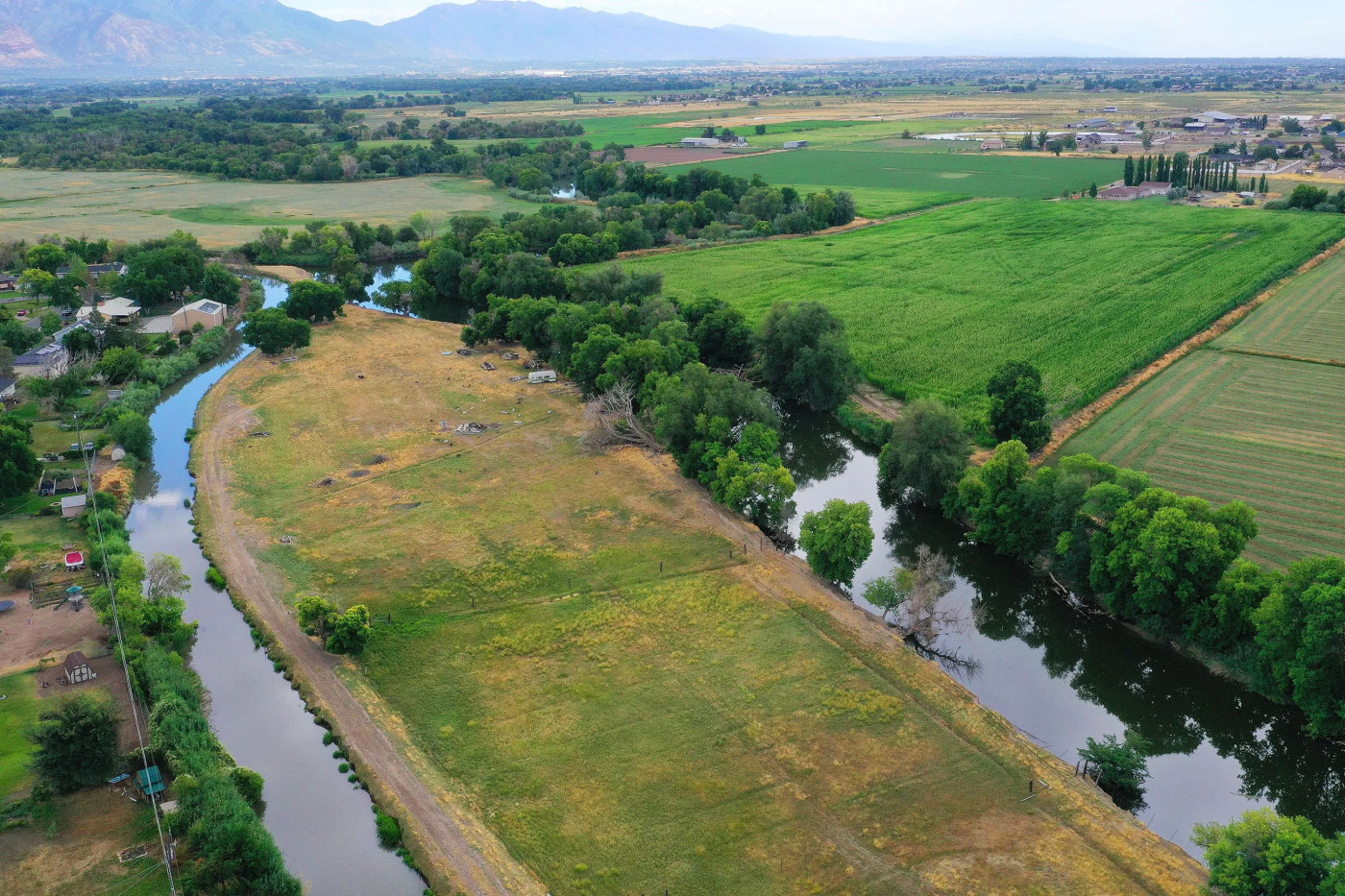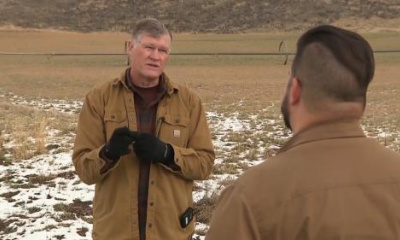Great Salt Lake Watershed Enhancement Trust helps people like this Weber County farmer help the lake
President Joe Biden made an historic announcement Tuesday designating a new national monument in Arizona that in part is promoted as a way to help save the Colorado River.
The river serves 40 million people and is called the lifeblood of the West, in dire need due to drought and diversions. It is a topic of huge political controversy and environmental concern as the government and vested interests try to strike a path moving forward to save this river that built the West.
When Biden visits Utah on Wednesday, especially in light of his promotion of climate sustainability and resiliency, will he talk water?
Biden is in Utah to raise money and promote the PACT Act, a bill that expands health care coverage to veterans exposed to toxic burn pits. It’s unknown if he will bring up another critical water issue in Utah and in fact globally: the fate of the Great Salt Lake.
The saline lake dilemma
Water scarcity is the bulldozer in the West. Economy, sure. Health care, correct. Jobs, of course. But with Utah cities and other states forced with stunning reductions of water allotments, running out of water in the arid West may not be on the radar of many political leaders who enjoy a different climate. They may not also understand the importance of this lake that is huge, smelly, wonderful and a gift to millions of migratory birds and a cultural identity that defines Utah.
But the Great Salt Lake is a different animal, in need of attention, one of many saline lakes across the country and world that are drying up.
Utah is trying to arrive at solutions, and Brad Blanch may be one of them.
Blanch lives at the far reaches of western Weber County, where John Deere tractors and other farming equipment rumble down narrow roads past wide-open stretches of crops, pastures, horses and cows.
A few minutes away from his barn-style home, he points out the West Weber place where he grew up, rising at 5 a.m. before the start of his high school day to milk cows. He likes to joke with his wife, Deena, that the chemical smell that lingered from his chores is what attracted all the girls to him back in the day.
“It just sticks with you,” he said. “You don’t realize it until you get away from it.”
He inherited land once owned by his grandfather and used for alfalfa and onions; over the years he has also acquired more property. He now has two parcels of 160 acres and 60 acres.
This year, the land has been idled and the 500-acre feet of water that Blanch owns is sitting unused.
The water rights he owns are surface rights dating back to 1919 on the lower Weber River that at some point, he will use some of that for a pair of subdivisions he plans to develop. But for now, he wants to put it to good use to help save the Great Salt Lake.
Blanch knows that, and he contacted the Great Salt Lake Watershed Enhancement Trust to put the water and his right to it, to use.
“As all of us have watched the decline of the Great Salt Lake and I do have options to lease the water to other users. But this seemed to be an environmentally friendly and helpful way to put this water to use for the lake,” he said. “I would love to be able to help the Great Salt Lake. This year has been a great year, but it is not always that way.”
The pressure on the Great Salt Lake
The largest terminal salt water lake in the Western Hemisphere and the eighth largest in the world, the Great Salt Lake is in duress.
The lake hit a new record low in November last year, with its area and volume reduced by half due to years of diversion and drought. Its demise threatens its annual contribution of $1.32 billion to Utah’s economy and threatens 10 million birds that make the lake a resting stop, a place to dine or nest.
Its exposed lakebed threatens public health with winds that kick up dust laden with harmful heavy metals. The dust that finds its way to the Wasatch Mountains accelerates snowmelt, threatening not only a viable runoff but winter recreation, such as Utah’s critical ski industry.
An August Water Supply Outlook report released by the USDA’s Natural Resources Conservation Service said while the lake has risen about 4.5 feet, it still needs to rise about 7 to 13 more feet to return to “normal.”
Aside from the pressure on the Great Salt Lake, the extreme drought that has plagued Utah and the West has crippled some local culinary water supplies and severely threatened others. Some Utah water providers cut irrigators back to half or even quarter turns on their water allotments last summer, enacted time-of-day watering restrictions, and in the midst of searing heat and abysmal snowpack, Utah Gov. Spencer Cox implored residents to pray for rain.
Arriving at solutions
Over the last two years, Utah lawmakers made historic financial investments in the arena of water conservation, allocating nearly $1 billion in a nod to the state’s growing water scarcity problem.
One such expenditure was the establishment of the $40 million Great Salt Lake Watershed Enhancement Trust, run by The National Audubon Society and The Nature Conservancy. Lawmakers also turned Western water law on its head by altering the doctrine of “use it or lose it” to include the Great Salt Lake as a “beneficial use.”
Water rights by most owners have to be put to beneficial use in a seven-year time frame, or risk forfeiture to the state. Those uses include municipal, industrial and agricultural applications, but the Great Salt Lake was made a viable use with the passage of HB33 in 2022, which allows the water to be used for instream flows for sovereign lands. The bed of the Great Salt Lake is sovereign land, owned by the state.
“What that allows us to do is actually hold water rights for the benefit of Great Salt Lake which was something that previously our division could not hold,” said Ben Stireman, deputy director of the Utah Division of Forestry, Fire and State Lands.
“It is a good change, but it will take a lot of years to implement properly and have sufficient water rights.”
Via the state and the trust, water rights can be leased, for short or long-term durations, it can be donated or it can be purchased outright as a permanent fixture for the lake.
Stireman said it is a complicated process and ultimately has to be accomplished through approved change applications with the Utah State engineer.
He added that public interest in helping the Great Salt Lake in this manner has been robust.
“It’s been great. Since the moment that the water trust bill passed, our division started receiving calls from people who are interested in selling their water or donating it or leasing it. Some of them obviously are going to be dependent on where they are at,” and how complicated a diversion might be, he said.
Both Stireman and Marcelle Shoop, saline lakes program director for the National Audubon Society and executive director of the trust, said there are an ongoing number of negotiations happening with people. The trust officially launched this January, with Shoop saying the list of criteria is complex but designed to be of most benefit to the Great Salt Lake.
“The work of the trust is to bring water transactions to fruition for Great Salt Lake and also to help with restoring and protecting wetlands around Great Salt Lake to benefit the hydrology, the lake and so we’ve had a lot of work in both of those fronts going forward,” she said. “So in terms of prospects, I think we feel very positive about the opportunities out there and what we are seeing. We want to bring those opportunities to a place where they can be implemented.”
In Blanch’s case, the benefit of the trust allows him to put his unused water to use so he can hang onto it for the future. When his developments are complete, he expects to still have 350-acre feet of water that could be available to the trust for lease.
Wetlands are also a huge component of the health of the Great Salt Lake ecosystem, with the trust recently announcing $10 million that is available to protect or restore wetlands and habitats.
“Wetlands associated with Great Salt Lake are essential to the lake’s health and play an important role in connecting water flows and habitats that benefit the hydrology of the lake and the well-being of our communities as we look to the future,” Shoop emphasized.
Shoop said eligible applicants include state, local or municipal government entities, tribal governments, and nonprofit organizations. Private landowners, private entities, or institutions of higher education are eligible if working in partnership with a public/governmental entity or a nonprofit organization.
Applications must be submitted by midnight on Sept. 15.
Members of Utah’s congressional delegation have also dipped their toes into the space of saving the Great Salt Lake with a couple of bills that have been introduced and show promise of success.
Inspiring others
In March, The Church of Jesus Christ of Latter-day Saints announced it was donating, on a permanent basis, the equivalent of 20,000 acre-feet of water to the Great Salt Lake. An acre-foot is equal to an acre of water a foot deep. One acre-foot of water equals 325,851 gallons. For perspective, the donation is larger than 15,000 football fields covered by water a foot deep.
In 2021, two donations of water rights of approximately 21,000 acre-feet were secured to help the Farmington Bay wildlife area.
Multiple partners included the Utah Division of Wildlife Resources, Rio Tinto Kennecott, Central Utah Water Conservancy District, National Audubon Society, The Nature Conservancy, and Utah Reclamation Mitigation and Conservation Commission.
The water will be delivered for 10 years, subject to availability.
Shoop said recent donation by the church been inspiring others to step up.
“I think that is an example of what an organization can do that has water rights, and actual wet water rights,” she said. “It did spark a lot of interest when it was first announced and I hope it continues to actually inspire others.”
Stireman said he can only see the momentum growing when it comes to these creative ways to get more water to the ailing lake.
“I think that our community cares a lot about the Great Salt Lake and obviously in the last two or three years, as the lake has been facing additional challenges, people have really stepped up and started to stand up for the lake and really care about the lake,” he said. “I think people have really kind of changed their mentality about the Great Salt Lake and began to look at it as a big amenity that we have here in Utah."








